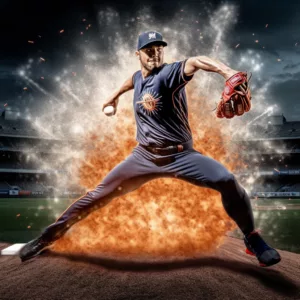 The 3X Pitching Mechanics Guide defines some revolutionary advanced pitching components that prove how to enhance the initial movement of the throwing arm as evident in a high velocity pitching delivery. Some of these 3X Advanced Components are Action to Reaction, the 3X to 2X Factor and the 3X Burst to name a few. The application of maximum force to load the arm, which in return will enhance the speed of the initial movement in the throwing arm, is what separates a high velocity pitcher from a low velocity pitcher.
The 3X Pitching Mechanics Guide defines some revolutionary advanced pitching components that prove how to enhance the initial movement of the throwing arm as evident in a high velocity pitching delivery. Some of these 3X Advanced Components are Action to Reaction, the 3X to 2X Factor and the 3X Burst to name a few. The application of maximum force to load the arm, which in return will enhance the speed of the initial movement in the throwing arm, is what separates a high velocity pitcher from a low velocity pitcher.
This increased load into the initial movement to enhance performance is best defined in the Stretch Shortening Cycle (SSC), which is listed as another 3X Advanced Component in the 3X Pitching Mechanics Guide. The SSC is critical because this is how the body generates the energy to multiply forces. A case study performed by Grezios AK, Gissis IT, Sotiropoulos AA, Nikolaidis DV, Souglis AG. at the Laboratory of Biomechanics, Department of Physical Education and Sport Sciences, Aristotelian University of Thessaloniki, Thessaloniki, Greece called, Muscle-contraction properties in overarm throwing movements proves the importance of loading the arm with force to enhance the speeds of the initial movement, which implements the SSC and increases throwing velocity. Here is the results from the case study:
The results support the thesis that the stretch-shortening cycle is the type of muscle contraction in unloaded overarm throws. Furthermore, it is possible to increase the throw velocity by increasing the velocity of the initial movement (i.e., by provoking higher inertia forces).
Read the entire study here: http://www.ncbi.nlm.nih.gov/pubmed/16503670
The case study defines the baseball throwing motion as an unloaded throw. This means a eccentric load is being applied to the throwing arm to implement the SSC and then the arm moves into acceleration as it unloads into a concentric reaction. Following the results of the case study they advise overarm throwing athletes to increase pitching velocity by provoking higher ineartia forces to increase the load and in return enhance the initial movement of the throwing arm. The initial movement specific to this case study was the moment the arm is accelerating forward out of external rotation. This case study did not just address pitching specifically, it covered all overarm throwing sports in general. To truly understand the value of this case study and its findings we need to understand how these results translate into the high velocity pitcher. 3X Pitching will help us do this.
3X Pitching Enhances the Initial Movement
3X Pitching defines this initial movement to the throwing arm along with how to provoke higher inertia forces as advise in the case study. The case study implies that the moment of unloading of the movement is the initial movement and the loading of the movement must be applied with force to enhance velocity. What the case study does not tell us is how do we enhance the force to the throwing arm, but 3X Pitching has given us this answer; Triple Extension (3X).
Notice the picture of Derek Holland above, he has one of the highest average fastballs for a starter in the MLB, his drive leg is completely extended and his front foot is completely off the ground. Why is he doing this and why does 99% of low velocity pitcher never implement this movement? The answer is he is provoking higher inertia forces. This is exactly what the case study advised the overarm throwing athlete to do to increase throwing velocity. To make sure we are all on the same page here let's first define the word inertia. This is from the Google dictionary:
Inertia: A property of matter by which it continues in its existing state of rest or uniform motion in a straight line, unless that state is changed by an external force.
This means that the force being provoked is moving in a straight line. How can a pitcher generate maximum force in the pitching delivery in a straight line? The answer is driving or extending the back leg into 3X. There is no other way to generate this high level of force in the pitching delivery without triple extending the drive leg. Remember this action is to load the throwing arm to enhance the initial movement. The question now is how does this driving 3X force apply the load to the throwing arm? The answer is Hip to Shoulder Separation. As the drive leg is extending into 3X it will push the hips open if the pitcher can 3X before or just at front foot strike. This opening of the hips early following front foot strike will separate the hips from shoulders keeping the throwing arm cocked behind the head as in the picture above of Derek Holland. This generates core torque as the muscles are being stretched between the hips and shoulders. This torsion in the core will launch the shoulders towards the target as the arm lays back into external rotation loading the throwing arm to enhance the initial movement as recorded in the case study.
You will never accomplish what 3X can accomplish by swinging the arm or rotating the body to generate the same kind of load on the arm as with 3X and Hip to Shoulder Separation. To learn more about these movements that will enhance the initial movement of the throwing arm and increase pitching velocity, check out both the 3X Pitching Velocity Program and the 3X Pitching Mechanics Guide TODAY!

